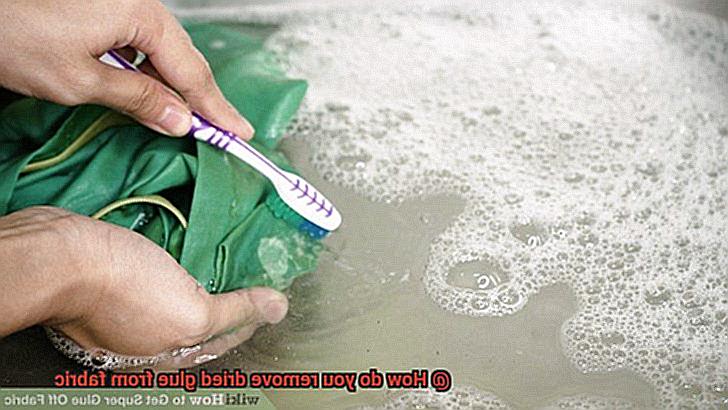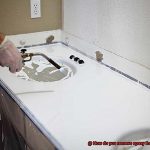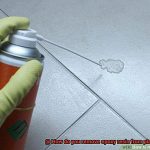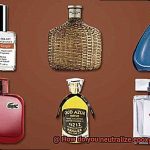Picture this: you’re working on a crafting project, and before you know it, there’s dried glue all over your favorite fabric. It’s not just unsightly; it can also reduce the fabric’s durability and lifespan. As someone who loves working with fabrics, I’ve faced this problem countless times and researched various methods to remove dried glue effectively. Today, I’m excited to share some tried-and-tested techniques with you.
Whether you’re a seasoned crafter or just starting on your DIY journey, dealing with sticky residue is never fun. But fear not. In this blog post, we’ll explore the best ways to remove dried glue from your fabric quickly and efficiently.
We’ll cover various methods such as using solvents, heat, vinegar, and professional cleaners – each with its own unique benefits. Plus, we’ll look at suitable tools and materials that can make the process smoother.
If you’ve been struggling to get rid of those pesky dried glue stains from your favorite fabrics, then stay tuned. With our expert tips and tricks, you’ll be able to tackle them in no time. So let’s dive right in and get those sticky stains out once and for all.
What is Glue and How Does it Work?
Contents
- 1 What is Glue and How Does it Work?
- 2 Types of Glue and Their Effects on Fabric
- 3 Acting Quickly to Remove Dried Glue from Fabric
- 4 Scraping Off Excess Glue from Fabric
- 5 Removing the Residue with Vinegar
- 6 Removing the Residue with Rubbing Alcohol
- 7 Removing the Residue with Glycerin
- 8 Using Heat to Remove Dried Glue from Fabric
- 9 Conclusion
Glue, a type of adhesive used to bond two surfaces together, is a crucial tool for DIY projects and repairs. It comes in a variety of forms, such as liquid, paste, or solid, and is made up of different chemicals. The most common types of glue are synthetic polymers like polyvinyl acetate (PVA) and cyanoacrylate.
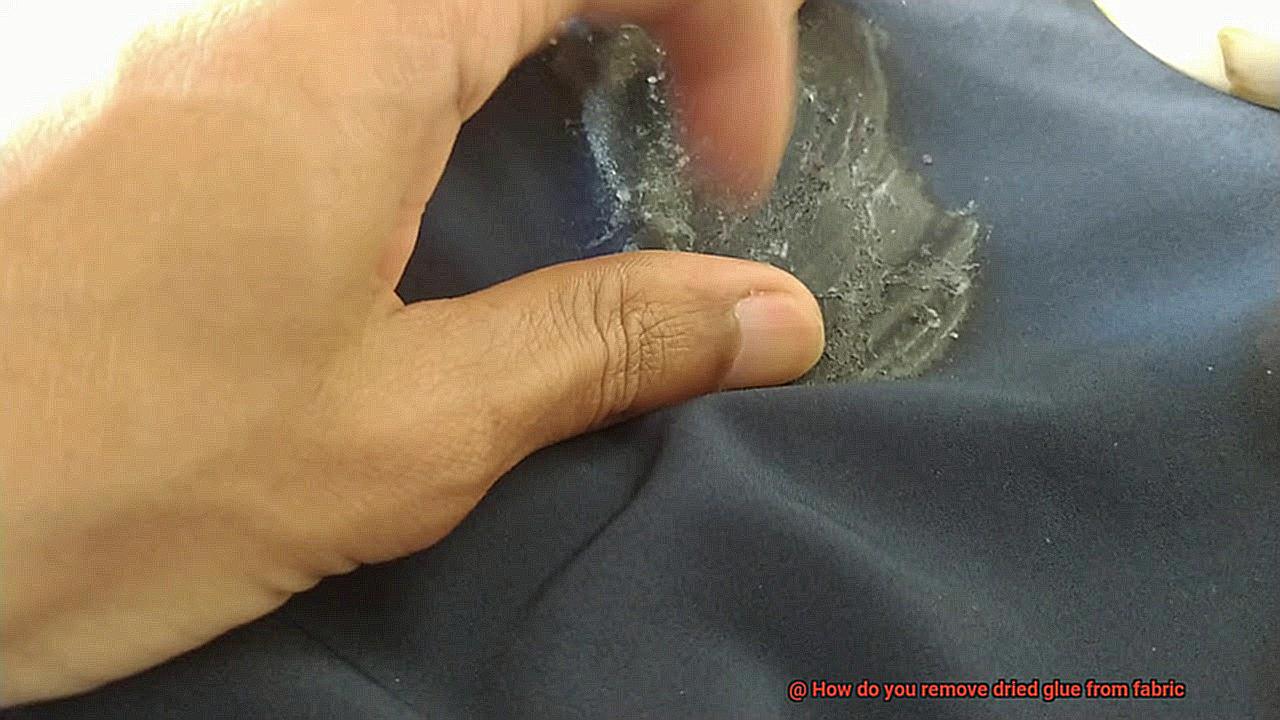
The magic of glue lies in its ability to create a bond between two surfaces through a chemical reaction. As it dries and hardens, the glue reacts with the air to form a strong bond between the two surfaces. However, not all glues work the same way. For example, PVA glue creates a hydrogen bond between surfaces being bonded and is mainly used for woodworking and paper crafts. In contrast, cyanoacrylate glue creates a strong bond by reacting with water vapor in the air and is often used for bonding plastic and metal surfaces.
Removing dried glue from fabric can be quite a challenge. However, with the right tools and techniques, it can be done. The first step is to act quickly and remove as much excess glue as possible using a dull knife or spoon. Then, vinegar, rubbing alcohol, glycerin, or heat can be used to remove the remaining residue.
Types of Glue and Their Effects on Fabric
Accidentally spilling glue on fabric can be a nightmare, but it doesn’t have to be. Knowing the type of glue used and its effects on fabric when it comes to removal is essential. Below are five sub-sections explaining different types of glue and their effects on fabric when removing dried glue.
White School Glue
White school glue, also known as PVA (polyvinyl acetate) glue, is a water-soluble adhesive that is easy to remove from fabric. Soaking the affected area in warm water and gently scrubbing it with a sponge or brush should do the trick. However, if the glue has already dried, it may require using vinegar or rubbing alcohol to dissolve it. Avoid using hot water or a dryer to dry the fabric, as this can cause the glue to set permanently.

Super Glue
Super glue, also known as cyanoacrylate glue, is not water-soluble and can be challenging to remove from fabric. It is best to act fast before it dries. Use acetone or nail polish remover to dissolve the glue, then rinse the fabric thoroughly with water. But before applying these substances, test a small area of the fabric first to avoid causing damage.
Hot Glue
Hot glue is a common adhesive in crafting projects that hardens quickly and forms a strong bond. Removing hot glue from fabric requires a combination of heat and scraping. Gently heat the affected area with a hairdryer or iron to soften the glue, then scrape it off with a plastic scraper or credit card.
Fabric Glue
Fabric glue is specifically designed for use on fabric and can be particularly challenging to remove if it dries on clothing or upholstery. To remove dried fabric glue, try using a mixture of hot water and dish soap or laundry detergent. Soak the affected area in the solution for several minutes, then gently scrub the glue away with a soft-bristled brush.
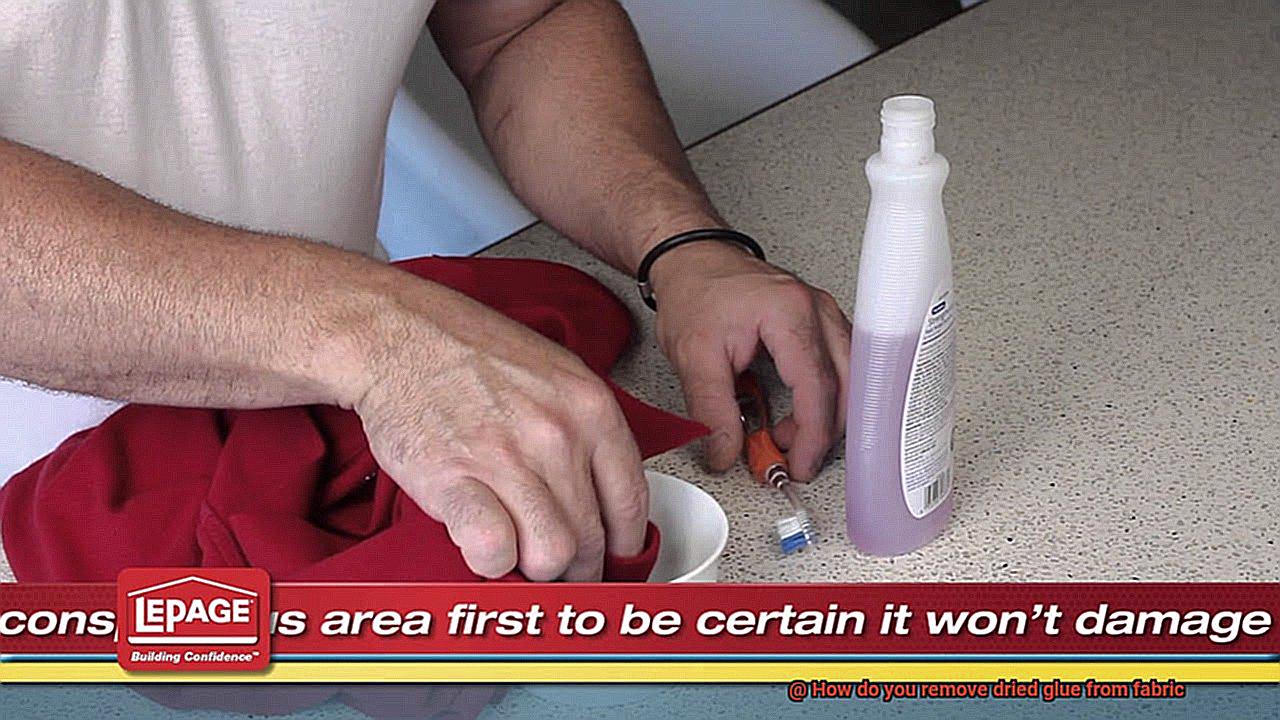
Glycerin and Heat
Glycerin is a natural lubricant that can help soften dried glue, making it easier to remove. Apply glycerin to the affected area and let it sit for a few minutes before rubbing gently with a soft cloth. Rinse thoroughly with water and repeat if necessary. Heat can also be used to remove dried glue from fabric. Place a clean cloth over the affected area and iron over it on a low heat setting. The heat will soften the glue, allowing it to be scraped off more easily.
Acting Quickly to Remove Dried Glue from Fabric
Imagine this: you’re in the midst of an exciting DIY project, only to discover a pesky blob of dried glue on your beloved fabric. Fear not, my friend. As an expert in removing dried glue from fabric, let me guide you through the process.
Acting quickly is vital when it comes to removing dried glue from fabric. The longer you wait, the more challenging it becomes to remove the glue. Therefore, as soon as you notice it, it’s time to take action.
Here are some tips for quickly and effectively removing dried glue from your fabric:
Begin by scraping off as much dried glue as possible with a plastic scraper or credit card, being careful not to damage the fabric.
If the glue is still wet, use a damp cloth to gently wipe it away.
For dried glue, create a solution of warm water and dish soap and soak the affected area for about ten minutes. Then, using a soft-bristled brush, delicately scrub the area until the glue starts to loosen. Rinse with clean water and repeat if necessary.
Rubbing alcohol or nail polish remover may also do the trick. Apply a small amount onto a clean cloth and gently rub the affected area until the glue dissolves. However, be sure to test a small, inconspicuous area first before applying it to a larger area.
In case all else fails, commercial adhesive removers can come in handy. These products are available at most hardware or home improvement stores. Always follow instructions carefully and test a small area first before using it on the entire affected area.
Remember always to read the care label on your fabric before attempting any cleaning methods. Some fabrics may be sensitive to certain chemicals and require special care.
Scraping Off Excess Glue from Fabric
The first step in removing dried glue from fabric is to scrape off as much of the excess glue as possible. A dull knife or scraper, such as a credit card or spatula, can be used for this task. Be gentle and cautious not to damage the fabric. It’s essential to remove as much of the excess glue as possible before attempting any other removal methods.
If the glue has hardened and is challenging to scrape off, try softening it with a damp cloth for a few minutes before scraping. Note that different types of glue may require different scraping methods. For instance, hot glue may need to be softened further using a heat gun or hair dryer.
Once you have removed as much of the excess glue as possible, you can move on to other removal methods such as using solvents or washing the fabric. However, if you’re dealing with delicate fabrics or stubborn stains, it’s always best to consult a professional cleaner for advice.
To sum up, follow these easy steps for removing excess glue from fabric:
- Use a dull knife or scraper to gently scrape off as much of the excess glue as possible.
- Soften the glue if necessary using a damp cloth or heat gun.
- Consult a professional cleaner if dealing with delicate fabrics or stubborn stains.
Removing the Residue with Vinegar
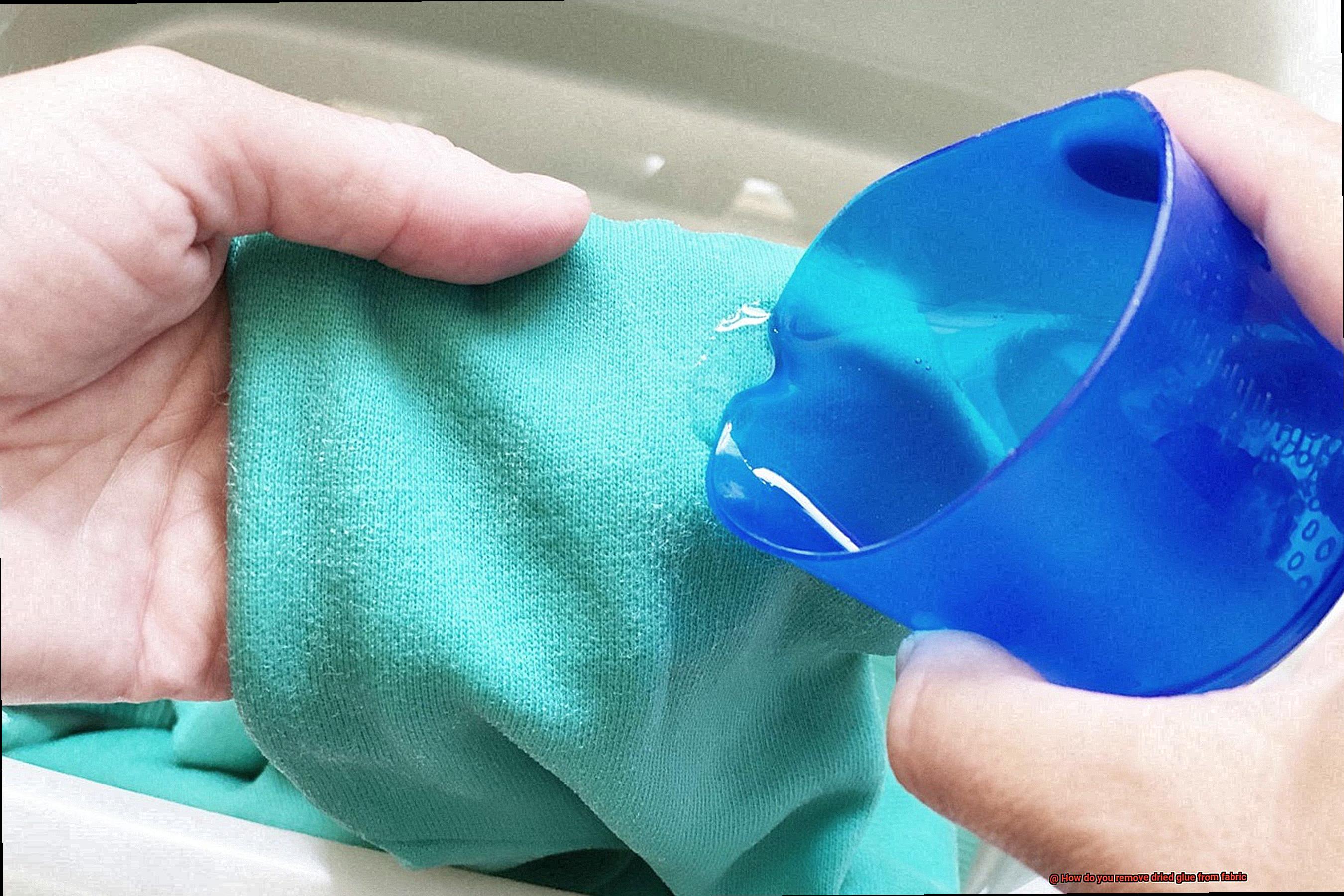
Look no further than your kitchen pantry for a simple and effective solution – white vinegar.
To get started, gather your supplies: white vinegar, warm water, and a clean cloth. Mix equal parts of vinegar and warm water in a bowl, then soak the stained area of the fabric in the solution for 10-15 minutes. This will help to loosen the glue residue before you begin to remove it.
Using a clean cloth, gently blot the stain until you start to see progress. If the glue is stubbornly sticking to the fabric, apply more vinegar solution directly to the stain and let it sit for a few minutes before blotting again. Avoid rubbing or scrubbing too hard, which can damage the fabric fibers.
Once all the glue residue is removed, rinse the fabric thoroughly with warm water to remove any remaining vinegar solution. Finally, wash the fabric as usual with laundry detergent and let it air dry.
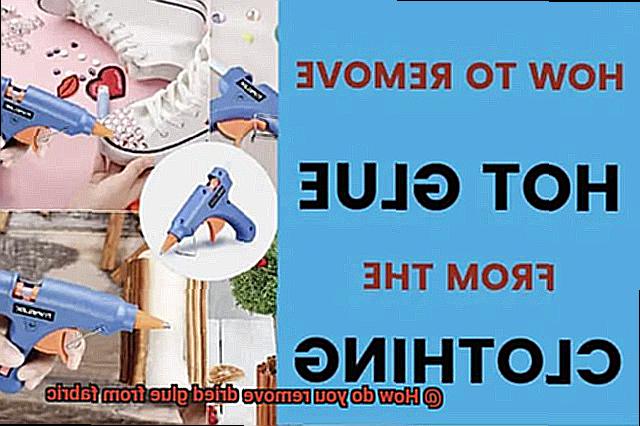
Using vinegar to remove glue residue is not only effective but also affordable and eco-friendly. Say goodbye to harsh chemicals and expensive professional cleaning services. Remember these simple steps the next time you encounter a glue-stained shirt or piece of upholstery.
Removing the Residue with Rubbing Alcohol
With the help of rubbing alcohol, you can easily remove dried glue from fabric and restore your garments to their former glory.
Rubbing alcohol is a versatile solvent found in most medicine cabinets or first aid kits. It’s effective at dissolving a wide range of substances, including glue, making it an ideal solution for removing residue left behind after scraping off as much of the dried glue as possible.
Here’s a step-by-step guide on how to use rubbing alcohol to remove dried glue from fabric:
Step 1: Gather Your Materials
You’ll need rubbing alcohol, a clean cloth, and a bowl. It’s essential to use a clean cloth that doesn’t have any other substances on it that could further damage the fabric.
Step 2: Apply Rubbing Alcohol
Pour some rubbing alcohol into the bowl and dip the clean cloth into it. Gently rub the cloth over the affected area, being careful not to damage the fabric. The dried glue will start to dissolve and come off onto the cloth as you rub.
Step 3: Repeat as Necessary
Continue this process until all of the residue has been removed. If you’re dealing with a particularly stubborn or large amount of dried glue, you may need to repeat this process several times or seek professional assistance.
Step 4: Rinse Thoroughly
After removing all of the residue with rubbing alcohol, rinse the fabric thoroughly with water to remove any remaining traces of alcohol.
It’s crucial to note that rubbing alcohol may not work on all types of glue or fabric. Before attempting this method, test a small inconspicuous area of the fabric to ensure that it won’t be damaged by the rubbing alcohol.
Removing the Residue with Glycerin
Fear not, for glycerin is here to save the day. This colorless and odorless liquid is a common and effective solvent that can make removing glue residue a breeze.
What’s even better is that glycerin is gentle enough to be used on most types of fabrics. It’s commonly used in the cosmetic and pharmaceutical industries, making it a reliable solution for your fabric woes.
So, how does it work? Glycerin works by breaking down the chemical bonds in the glue, making it easier to remove from the fabric. Here’s how you can use glycerin to remove dried glue residue from your fabric:
Supplies you will need:
- Glycerin
- A clean cloth or sponge
- Warm water
Step 1: Apply glycerin
Apply a small amount of glycerin to the affected area of the fabric. You can use your fingers or a clean cloth to work the glycerin into the fabric and let it sit for a few minutes. This gives the glycerin time to break down the glue bonds.
Step 2: Rub with warm water
Next, use a clean cloth or sponge soaked in warm water to gently rub the area where the glue residue is located. The warm water will help to loosen the glue from the fabric fibers. Keep rubbing until all of the glue residue has been removed.
Step 3: Rinse and launder
Once you’ve removed all of the glue residue, rinse the fabric thoroughly with warm water to remove any remaining glycerin. Make sure you launder the fabric as usual to remove any traces of glycerin or glue residue.
It’s important to note that some fabrics may require a gentler method for removing glue residue. If you’re unsure, consult with a professional dry cleaner or follow the care instructions on the garment label.
Using Heat to Remove Dried Glue from Fabric
I am here to share with you a highly effective solution – using heat.
To start, it’s important to note that this method is only suitable for fabrics that can withstand heat. If you’re unsure, it’s always best to test on a small area first before committing to larger areas of fabric.
Firstly, place the fabric with the dried glue on an ironing board or flat surface. Cover the glue with a clean cloth or paper towel to prevent it from sticking to the iron. For optimal results, use a low heat setting on your iron to avoid damaging the fabric.
Gently press the iron onto the cloth or paper towel over the glue and move it back and forth for several minutes until the glue starts to soften. Keep checking the fabric frequently to ensure it’s not getting too hot or damaged by heat. Once you notice the glue softening, remove the iron and gently peel off the cloth or paper towel. The dried glue should come off with it.
If there’s still some glue residue left on the fabric, repeat the process until all of it is removed. And voila. Your fabric is now free of stubborn glue stains.
It’s worth noting that delicate fabrics like silk or nylon may melt or become damaged when exposed to high temperatures. In these cases, it’s best to use alternative methods like vinegar or rubbing alcohol to remove the glue.
In summary, using heat to remove dried glue from fabric is a quick and easy solution that can save your favorite clothes from being ruined by stubborn stains. Here are some quick tips to keep in mind:
- Use this method only on fabrics that can withstand heat.
- Test on a small area first before committing to larger areas of fabric.
- Use a low heat setting on your iron.
- Be gentle and patient when applying heat to the fabric.
- If you’re unsure, seek professional help or try alternative methods.
uArs8OAVQT4″ >
Conclusion
Don’t let dried glue stains ruin your favorite fabric items. With the right tools and techniques, you can easily remove them in no time. From hot glue to super glue, there are various methods to tackle each type of glue stain effectively.
Our comprehensive guide covers everything you need to know about removing dried glue from fabric. We explored different types of glues and their effects on fabrics, along with various removal methods like solvents, heat, vinegar, and professional cleaners – each with its unique benefits. Additionally, we provided insight into suitable tools and materials that can make the process smoother.
Acting quickly is crucial when it comes to removing dried glue from fabric. The longer you wait, the more difficult it becomes to remove the stain. So don’t waste any time.
Remember always to check the care label on your fabric before attempting any cleaning methods. Some fabrics may be sensitive to certain chemicals and require special care.
In conclusion, removing dried glue from fabric is possible with the right techniques and tools.

